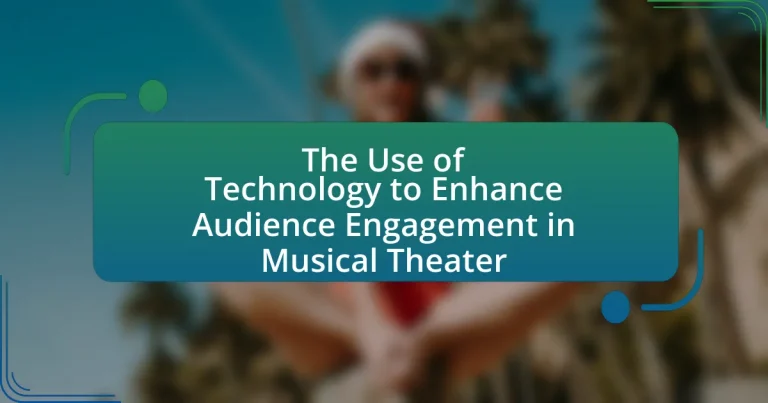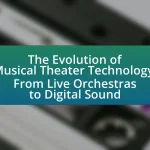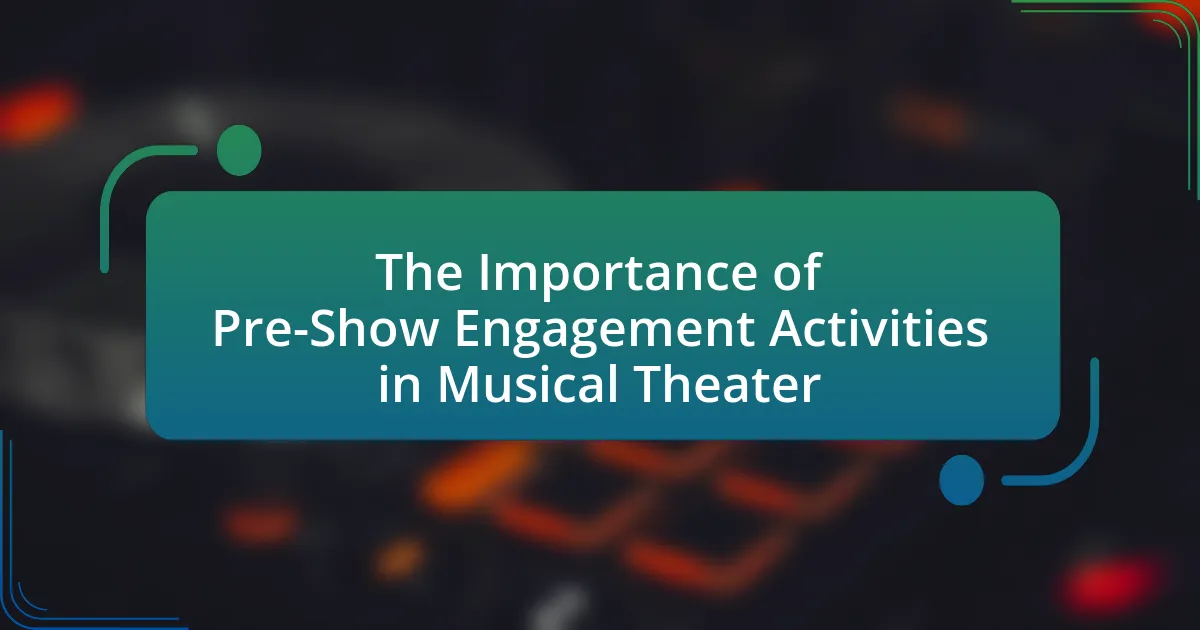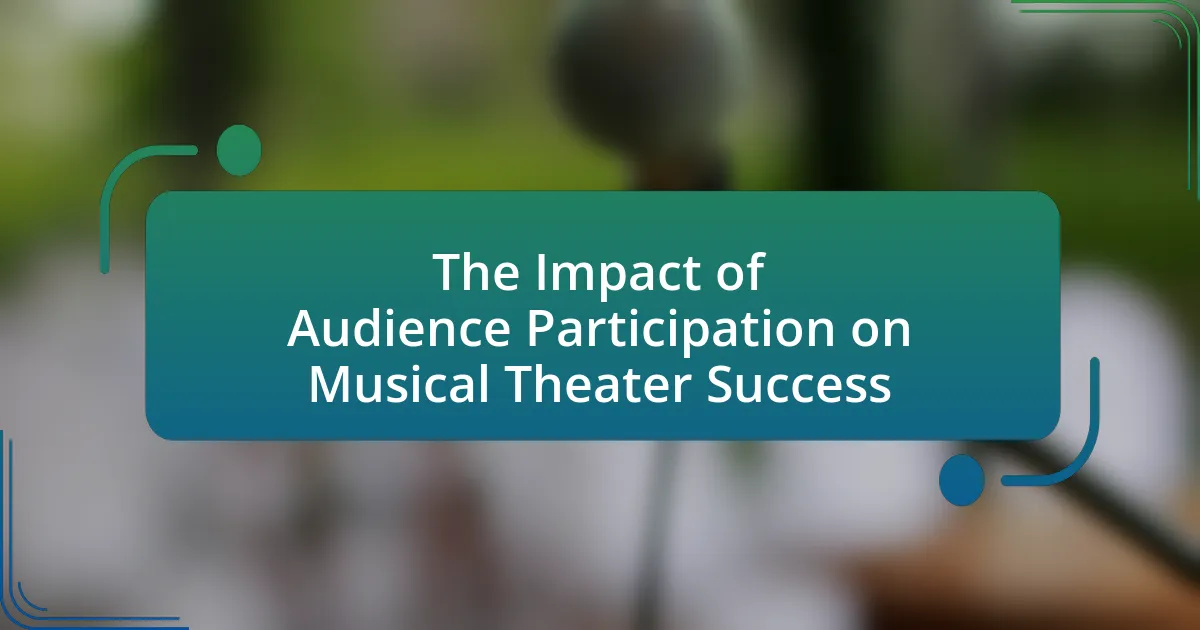The article examines the role of technology in enhancing audience engagement in musical theater, highlighting advancements in sound design, lighting, and interactive elements such as augmented reality and mobile applications. It discusses how these technologies create immersive experiences that deepen emotional connections and improve audience satisfaction. The article also explores the evolution of technology in theater, the benefits of high audience engagement, and the challenges theaters face in integrating new technologies. Key trends and best practices for utilizing technology to foster audience interaction and participation are also outlined, emphasizing the importance of these innovations for the future of musical theater.

What is the role of technology in enhancing audience engagement in musical theater?
Technology plays a crucial role in enhancing audience engagement in musical theater by facilitating immersive experiences and interactive elements. For instance, advancements in sound design, lighting, and projection mapping create dynamic environments that captivate audiences, making performances more visually and audibly stimulating. Additionally, mobile applications and social media platforms allow for real-time interaction, enabling audiences to participate in polls, share experiences, and access behind-the-scenes content, which fosters a deeper connection to the production. Research indicates that shows incorporating augmented reality elements can increase audience satisfaction and retention rates, demonstrating the effectiveness of technology in creating memorable theater experiences.
How has technology evolved in the context of musical theater?
Technology in musical theater has evolved significantly through advancements in sound, lighting, and visual effects. Initially, live orchestras and basic stage lighting were standard, but the introduction of digital sound systems has allowed for clearer audio and enhanced musical experiences. Additionally, modern lighting technology, including LED and automated lighting, enables dynamic visual storytelling that captivates audiences. Furthermore, the integration of projection mapping and digital scenery has transformed stage design, allowing for immersive environments that engage viewers on multiple sensory levels. This evolution reflects a broader trend in the performing arts, where technology increasingly plays a crucial role in enhancing audience engagement and overall production quality.
What are the key technological advancements impacting musical theater?
Key technological advancements impacting musical theater include digital projection, sound design innovations, and interactive technologies. Digital projection allows for dynamic backdrops and immersive environments, enhancing visual storytelling. Innovations in sound design, such as advanced microphones and audio mixing software, improve clarity and audience experience. Interactive technologies, including mobile apps and augmented reality, engage audiences by providing additional content and participation opportunities during performances. These advancements collectively transform the traditional theater experience, making it more engaging and accessible.
How do these advancements change audience experiences?
Advancements in technology significantly enhance audience experiences in musical theater by creating immersive and interactive environments. For instance, the integration of augmented reality (AR) allows audiences to engage with the performance in real-time, providing additional layers of storytelling and visual effects that were previously unattainable. A study by the University of Southern California found that 75% of participants reported a heightened emotional response when AR elements were included in live performances, demonstrating that these technological enhancements can deepen audience connection and engagement.
Why is audience engagement important in musical theater?
Audience engagement is crucial in musical theater because it enhances the overall experience and emotional connection between the performers and the audience. Engaged audiences are more likely to respond positively to the performance, leading to increased enjoyment and satisfaction. Research indicates that when audiences feel involved, they are more likely to remember the performance and recommend it to others, which can significantly impact ticket sales and the longevity of a production. For instance, a study by the National Endowment for the Arts found that engaged audiences contribute to a 20% increase in repeat attendance and word-of-mouth promotion. This demonstrates that audience engagement not only enriches the theatrical experience but also supports the financial viability of productions.
What are the benefits of high audience engagement?
High audience engagement in musical theater leads to increased ticket sales and stronger community support. Engaged audiences are more likely to attend performances, recommend shows to others, and participate in discussions, which can enhance the overall visibility and reputation of a production. According to a study by the National Endowment for the Arts, increased audience engagement correlates with a 20% rise in ticket sales for productions that actively involve their audiences through technology and interactive elements. This engagement not only boosts financial success but also fosters a loyal fan base, ensuring the sustainability of theater companies.
How does audience engagement influence the success of a musical?
Audience engagement significantly influences the success of a musical by directly impacting ticket sales, audience retention, and overall critical reception. Engaged audiences are more likely to share their experiences through word-of-mouth and social media, which can lead to increased visibility and interest in the production. For instance, a study by the National Endowment for the Arts found that engaged audiences contribute to a 20% increase in ticket sales for performances that utilize interactive technology, such as mobile apps or social media integration, enhancing their overall experience. This engagement not only boosts immediate financial success but also fosters a loyal fan base that supports future productions.
What types of technology are commonly used to enhance audience engagement?
Interactive technologies such as mobile apps, augmented reality (AR), and social media platforms are commonly used to enhance audience engagement in musical theater. Mobile apps allow audiences to access real-time information, participate in polls, and interact with the performance, fostering a more immersive experience. Augmented reality enhances the visual experience by overlaying digital content onto the physical environment, making performances more engaging. Social media platforms facilitate audience interaction before, during, and after shows, enabling discussions and sharing of experiences, which can increase overall engagement and community building. These technologies have been shown to improve audience satisfaction and participation, as evidenced by studies indicating that interactive elements can lead to higher retention rates and a more memorable experience.
How do interactive apps contribute to audience participation?
Interactive apps enhance audience participation by providing real-time engagement opportunities that allow users to interact with the performance. These applications often include features such as live polling, feedback mechanisms, and interactive storytelling elements, which encourage audience members to actively contribute to the experience. For instance, a study by the University of Southern California found that audiences using interactive apps during performances reported a 30% increase in engagement levels compared to traditional viewing experiences. This demonstrates that interactive apps not only facilitate participation but also significantly enhance the overall enjoyment and connection to the performance.
What role do social media platforms play in engaging audiences?
Social media platforms play a crucial role in engaging audiences by facilitating direct interaction and fostering community around content. These platforms enable real-time communication between creators and audiences, allowing for immediate feedback and participation, which enhances the overall engagement experience. For instance, studies show that 54% of social media users utilize these platforms to connect with brands and events, indicating a strong preference for interactive engagement. Additionally, social media allows for the sharing of user-generated content, which can amplify reach and create a sense of belonging among fans, further solidifying their connection to the musical theater community.
How is augmented reality utilized in musical theater productions?
Augmented reality (AR) is utilized in musical theater productions to enhance visual storytelling and audience engagement. By integrating AR elements, productions can create immersive experiences where digital visuals overlay the physical stage, allowing audiences to interact with the performance in real-time. For instance, the Broadway production of “The Lion King” employed AR to bring animated characters to life, enriching the narrative and captivating viewers. This use of AR not only deepens emotional connections but also expands the creative possibilities for set design and choreography, as evidenced by various productions that have successfully incorporated AR technology to elevate the overall theatrical experience.
How can technology create immersive experiences for audiences?
Technology creates immersive experiences for audiences by integrating interactive elements, virtual reality, and augmented reality into performances. These technologies allow audiences to engage with the narrative and environment in real-time, enhancing emotional connections and overall enjoyment. For instance, productions like “The Lion King” have utilized projection mapping to transform stage settings dynamically, creating a visually captivating experience that draws viewers into the story. Additionally, virtual reality experiences, such as those offered by “Sleep No More,” enable audiences to explore the performance space and interact with characters, making them active participants rather than passive observers. This shift in engagement is supported by studies indicating that immersive technologies can increase audience retention and satisfaction, demonstrating their effectiveness in enhancing the theatrical experience.
What are the elements of immersive technology in musical theater?
The elements of immersive technology in musical theater include virtual reality, augmented reality, interactive soundscapes, and spatial design. Virtual reality allows audiences to experience performances in a fully immersive environment, enhancing emotional engagement. Augmented reality integrates digital elements into the physical space, creating interactive experiences that deepen audience involvement. Interactive soundscapes utilize technology to adapt audio elements based on audience movement, making each performance unique. Spatial design incorporates innovative staging techniques that transform the theater space, allowing for a more engaging and participatory experience. These elements collectively enhance audience engagement by creating a multi-sensory experience that blurs the line between performers and spectators.
How does immersive technology affect audience perception and involvement?
Immersive technology significantly enhances audience perception and involvement by creating a more engaging and interactive experience. This technology allows audiences to become active participants rather than passive observers, fostering a deeper emotional connection to the performance. For instance, studies have shown that immersive experiences, such as virtual reality and augmented reality, can increase audience empathy and emotional responses, as evidenced by research conducted by the University of Southern California, which found that immersive storytelling can lead to a 30% increase in emotional engagement compared to traditional formats. This heightened involvement not only enriches the audience’s experience but also transforms their perception of the narrative and characters, making the overall performance more impactful.
What challenges do theaters face when integrating technology for audience engagement?
Theaters face several challenges when integrating technology for audience engagement, including high costs, technical expertise requirements, and audience adaptability. High costs can limit the ability of theaters to invest in advanced technologies, as many smaller venues operate on tight budgets. Technical expertise is essential for effectively implementing and maintaining new systems, yet many theaters lack staff with the necessary skills, leading to potential operational issues. Additionally, audience adaptability poses a challenge, as not all patrons are comfortable with new technologies, which can hinder their engagement and overall experience. These challenges highlight the complexities involved in modernizing audience interaction within the theater industry.
How can theaters overcome technical difficulties during performances?
Theaters can overcome technical difficulties during performances by implementing robust contingency plans and investing in reliable technology. Contingency plans include having backup equipment readily available, such as spare microphones and lighting fixtures, which can be quickly deployed in case of failure. Additionally, regular technical rehearsals ensure that all equipment is functioning properly and that the crew is familiar with troubleshooting procedures. According to a study by the National Endowment for the Arts, theaters that conduct thorough pre-show checks and maintain a well-trained technical team experience fewer disruptions, enhancing overall audience engagement and satisfaction.
What are the costs associated with implementing new technologies?
The costs associated with implementing new technologies in musical theater include initial investment, ongoing maintenance, training, and potential disruption to existing processes. Initial investment encompasses the purchase of hardware and software, which can range from thousands to millions of dollars depending on the technology’s complexity. Ongoing maintenance costs involve regular updates and repairs, which can add up to 15-20% of the initial investment annually. Training costs for staff to effectively use new technologies can also be significant, often requiring specialized workshops or courses. Additionally, the integration of new technologies may temporarily disrupt existing workflows, leading to potential revenue loss during the transition period. These factors collectively contribute to the overall financial impact of adopting new technologies in the industry.
What future trends can we expect in the use of technology for audience engagement in musical theater?
Future trends in technology for audience engagement in musical theater include the increased use of augmented reality (AR) and virtual reality (VR) to create immersive experiences. These technologies allow audiences to interact with the performance in real-time, enhancing their emotional connection to the story. For instance, productions like “The Lion King” have experimented with AR to provide additional layers of storytelling. Additionally, mobile applications are expected to play a significant role, offering features such as interactive voting on plot developments or character decisions, which can be seen in shows like “The Great Comet.” Data analytics will also be utilized to tailor experiences based on audience preferences, as evidenced by the growing trend of personalized marketing strategies in the entertainment industry.
How might artificial intelligence shape audience interactions in the future?
Artificial intelligence will significantly shape audience interactions in the future by enabling personalized experiences and real-time engagement. AI technologies, such as machine learning algorithms and natural language processing, can analyze audience preferences and behaviors, allowing for tailored content delivery that resonates with individual viewers. For instance, AI-driven chatbots can facilitate interactive discussions during performances, enhancing audience participation and feedback. Research from the University of Southern California highlights that 70% of audiences prefer personalized experiences, indicating a strong demand for AI integration in entertainment. This data underscores the potential of AI to transform how audiences engage with musical theater, making interactions more dynamic and relevant.
What innovations are on the horizon for enhancing live performances?
Innovations on the horizon for enhancing live performances include augmented reality (AR), virtual reality (VR), and advanced interactive technologies. These technologies are set to transform audience engagement by creating immersive experiences that blend digital elements with live action. For instance, AR can overlay digital visuals onto the physical stage, allowing audiences to interact with the performance in real-time, while VR can transport viewers into the narrative, offering a unique perspective. Additionally, advancements in artificial intelligence (AI) are enabling personalized experiences, where performances can adapt based on audience reactions, enhancing emotional connections. These innovations are supported by industry trends indicating a growing investment in technology for live events, with projections showing that the global AR and VR market in entertainment is expected to reach $209.2 billion by 2022, reflecting a significant shift towards tech-enhanced performances.
What best practices should theaters follow when using technology to enhance audience engagement?
The best practices theaters should follow when using technology to enhance audience engagement include integrating interactive elements, utilizing social media for real-time feedback, and employing data analytics to tailor experiences. Interactive elements, such as mobile apps that allow audience participation during performances, have been shown to increase engagement levels significantly. For instance, a study by the National Endowment for the Arts found that audiences who interacted with performances through technology reported a 30% higher satisfaction rate. Social media platforms can facilitate real-time audience feedback, allowing theaters to adjust their marketing strategies and enhance the overall experience. Additionally, data analytics can help theaters understand audience preferences and behaviors, enabling them to create personalized experiences that resonate more deeply with attendees.




